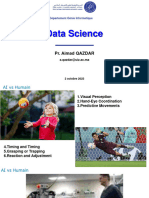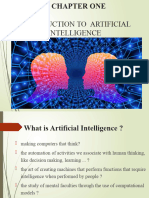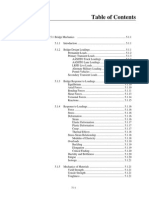Class Note
Uploaded by
makbel4Class Note
Uploaded by
makbel4Artificial Intelligence 501
Lesson 1
An introduction to AI and its History
- Image classification by ai was achieved in 2015 and they were able to perform
better than humans.
- Machine translation was achieved in 2016 and able to perform near human
performance.
Definitions :
Artificial Intelligence - a program that can sense, reason , act, and adapt.
Machine learning - Algorithms whose performance improve as they are exposed to
more data over time.
Deep learning - Subset of machine learning in which multilayered neural networks
learn from vast amounts of data.
Machine Learning - Algorithms whose performance improve as they are exposed to
more data over time.
Artificial Intelligence
“A branch of computer science dealing with the simulation of intelligent behavior in
computers.” (Merriam-Webster)
“Colloquially, the term 'artificial intelligence’ is applied when a machine mimics
‘cognitive’ functions that humans associate with other human minds, such as ‘learning’
and ‘problem solving’.” (Wikipedia)
Machine learning
“The study and construction of programs that are not explicitly programmed, but learn
patterns as they are exposed to more data over time.” (Intel)
Two Main types of machine Learning
Dataset Goal Example
Supervised Has a target column Make predictions Fraud detection
Learning
Unsupervised Does not have a Find structure in Customer
Learning target column the data segmentation
Artificial Intelligence 501
Machine Learning Example
- Suppose you wanted to identify fraudulent credit card transactions.
- You could define features to be :
> Transaction time
> Transaction amount
> Transaction location
> Transaction of purchase
- The algorithm could learn what feature combinations suggest unusual activity.
Deep Learning
Machine learning involves using very complicated models called “deep neural
networks”.
Models determine best representation of original data; in classic machine learning,
humans must do this.
History of AI
1950s: Early AI
• 1950: Alan Turing developed the Turing test to test a machine's ability to exhibit intelligent
jjjjjjjjjbehavior.
• 1956: Artificial Intelligence was accepted as a field at the Dartmouth Conference.
• 1957: Frank Rosenblatt invented the perceptron algorithm. This was the precursor to modern
neural networks.
• 1959: Arthur Samuel published an algorithm for a checkers program using machine learning
The First “AI Winter”
• 1966: ALPAC committee evaluated AI techniques for machine translation and determined
there was little yield from the investment.
• 1969: Marvin Minsky published a book on the limitations of the Perceptron algorithm which
slowed research in neural networks.
• 1973: The Lighthill report highlights AI’s failure to live up to promises.
• The two reports led to cuts in government funding for AI research leading to the first “AI
Winter.”
Artificial Intelligence 501
1980’s AI Boom
• Expert Systems - systems with programmed rules designed to mimic human experts.
• Ran on mainframe computers with specialized programming languages (e.g. LISP).
• Were the first widely-used AI technology, with two-thirds of "Fortune 500" companies using
them at their peak.
• 1986: The “Backpropagation” algorithm is able to train multilayer perceptrons leading to new
successes and interest in neural network research. Early expert systems machine 21
Another AI Winter (late 1980’s – early 1990s)
• Expert systems’ progress on solving business problems slowed.
• Expert systems began to be melded into software suites of general business applications (e.g.
SAP, Oracle) that could run on PCs instead of mainframes.
• Neural networks didn’t scale to large problems.
• Interest in AI in business declined.
Late 1990’s to early 2000’s: Classical Machine Learning
• Advancements in the SVM algorithm led to it becoming the machine learning method of
choice.
• AI solutions had successes in speech recognition, medical diagnosis, robotics, and many
other areas.
• AI algorithms were integrated into larger systems and became useful throughout industry.
• The Deep Blue chess system beat world chess champion Garry Kasparov.
• Google search engine launched using artificial intelligence technology.
2006: Rise of Deep Learning
• 2006: Geoffrey Hinton publishes a paper on unsupervised pre-training that allowed deeper
neural networks to be trained.
• Neural networks are rebranded to deep learning.
• 2009: The ImageNet database of human-tagged images is presented at the CVPR
conference.
• 2010: Algorithms compete on several visual recognition tasks at the first ImageNet
competition.
You might also like
- Seminar Report On Artificial Intelligence (AI)60% (15)Seminar Report On Artificial Intelligence (AI)15 pages
- Module-3 Association Analysis: Data Mining Association Analysis: Basic Concepts and AlgorithmsNo ratings yetModule-3 Association Analysis: Data Mining Association Analysis: Basic Concepts and Algorithms34 pages
- Describe Artificial Intelligence and Machine LearningNo ratings yetDescribe Artificial Intelligence and Machine Learning27 pages
- CSA(2001): Fundamental in AIML, Module 1No ratings yetCSA(2001): Fundamental in AIML, Module 165 pages
- Comprehensive Overview of Artificial Intelligence AINo ratings yetComprehensive Overview of Artificial Intelligence AI17 pages
- Fundamentals of AI, branches, applications, ApproachesNo ratings yetFundamentals of AI, branches, applications, Approaches58 pages
- Chapter Three: Artificial Intelligence (Ai)100% (2)Chapter Three: Artificial Intelligence (Ai)39 pages
- The AI Artificial Intelligence Course From Beginner to ExpertFrom EverandThe AI Artificial Intelligence Course From Beginner to ExpertNo ratings yet
- Differential geometry of manifolds Second Edition Lovett 2024 scribd downloadNo ratings yetDifferential geometry of manifolds Second Edition Lovett 2024 scribd download55 pages
- 3ms All Sequences Lesson Plans Worksheets Tutorial SessionsNo ratings yet3ms All Sequences Lesson Plans Worksheets Tutorial Sessions110 pages
- A Novel Oil-Immersed Medium Frequency Transformer For Offshore HVDC Wind FarmsNo ratings yetA Novel Oil-Immersed Medium Frequency Transformer For Offshore HVDC Wind Farms11 pages
- A Short Adaptation of James and The Giant PeachNo ratings yetA Short Adaptation of James and The Giant Peach13 pages
- Determination 446 Pesticides Residue by GC Ms and LC MsNo ratings yetDetermination 446 Pesticides Residue by GC Ms and LC Ms32 pages
- Worksheet in Zoology Lecture Animal Biodiversity (Part 1) : CalcareaNo ratings yetWorksheet in Zoology Lecture Animal Biodiversity (Part 1) : Calcarea3 pages
- Orthoptic Exercises Information Leaflet: OphthalmologyNo ratings yetOrthoptic Exercises Information Leaflet: Ophthalmology5 pages
- Infection Prevention and Control (IPC) For COVID-19 VirusNo ratings yetInfection Prevention and Control (IPC) For COVID-19 Virus21 pages

























































































